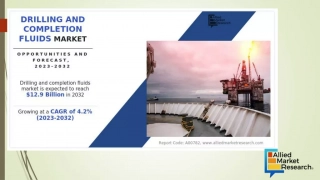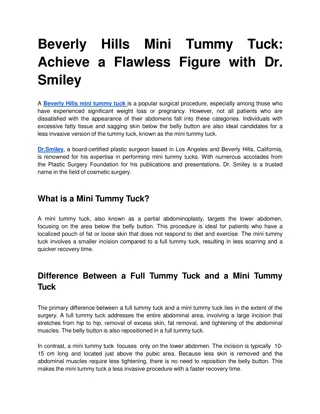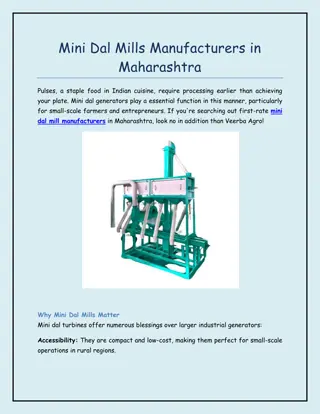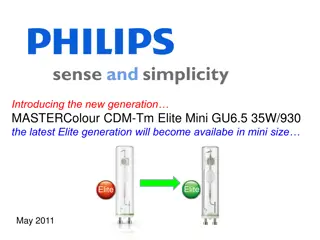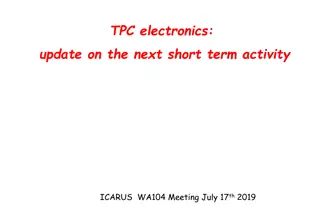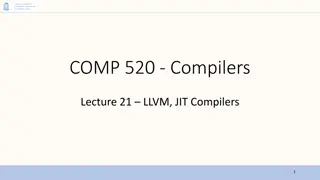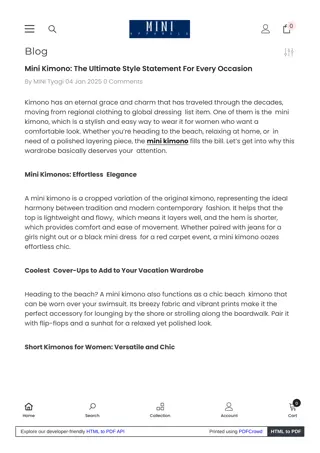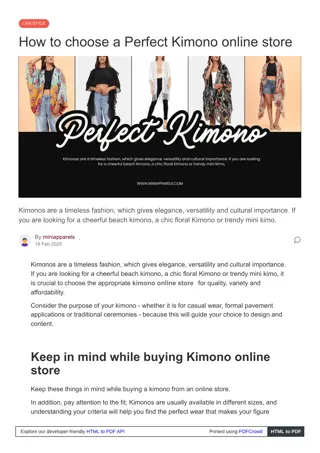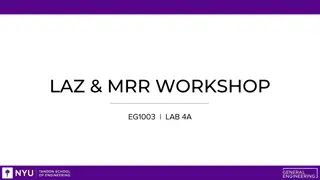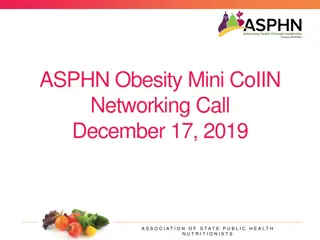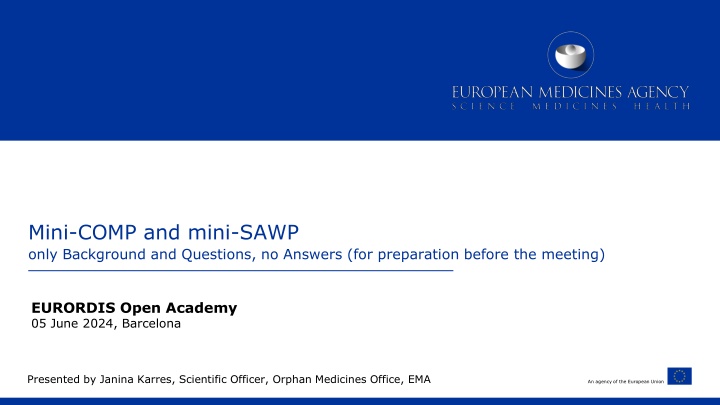
Orphan Designation (OD) for Medicinal Products in the EU
Learn about the orphan designation (OD) process for medicinal products in the European Union, the criteria for application, benefits for companies, and the regulatory procedures involved. Discover how OD incentivizes the development of treatments for rare diseases and the specific criteria that must be met for a successful orphan designation application.
Download Presentation

Please find below an Image/Link to download the presentation.
The content on the website is provided AS IS for your information and personal use only. It may not be sold, licensed, or shared on other websites without obtaining consent from the author. If you encounter any issues during the download, it is possible that the publisher has removed the file from their server.
You are allowed to download the files provided on this website for personal or commercial use, subject to the condition that they are used lawfully. All files are the property of their respective owners.
The content on the website is provided AS IS for your information and personal use only. It may not be sold, licensed, or shared on other websites without obtaining consent from the author.
E N D
Presentation Transcript
Mini-COMP and mini-SAWP only Background and Questions, no Answers (for preparation before the meeting) EURORDIS Open Academy 05 June 2024, Barcelona Presented by Janina Karres, Scientific Officer, Orphan Medicines Office, EMA An agency of the European Union
PART 1 Application for orphan designation (OD) 1 Classified as public by the European Medicines Agency
Orphan designation (OD) What? OD is an special status granted to medicinal products which provides companies with certain benefits. It is optional for Sponsors, not mandatory. Why? Encourages Development: It incentivizes companies to develop treatments for rare diseases that might otherwise be neglected due to limited market potential. What are the benefits? Fee Reductions for regulatory activities: Making the development process more affordable. Market Exclusivity: a period of about 10 years in which the medicinal products are protected against the authorization of similar competitor products, encouraging investment in research and development. 2 Classified as public by the European Medicines Agency
Application for orphan designation How and When? Regulatory procedure: Orphan Designation Scientific Advice/ Marketing Authorization Orphan Maintenance (Initial) Protocol Assistance Application Review Regulatory Committee: COMP SAWP/CHMP CHMP COMP Drug Development Phases Early (pre-clinical/early clinical) Late (clinical phase III completed) Preliminary data suggestive of a clinical benefit acceptable COMP: Committee for Orphan Medicinal Products CHMP: Committee for Human Medicinal Products SAWP: Scientific Advice Working Party (linked to CHMP) 3 Classified as public by the European Medicines Agency
Orphan designation (OD) criteria (EU) 1.Orphan Condition: The medicine must be intended for treatment, prevention, or diagnosis of a condition that is 1) a broad distinct disease entity(not disease subset), and 2) is life-threatening and/or chronically debilitating. 2.Prevalence: The prevalenceof the condition in the EU must not be more than 5 in 10,000 individuals (~ below 250.000) 3.Medical Plausibility: Is there a biologic rationale for the proposed drug to improve the condition? What is the pre-clinical or clinical data to show the (potential) benefits -> as minimum pre-clinical data in a valid animal model is required showing a benefit of the drug (i.e. functional/symptomatic improvement) 4. Significant Benefit: Only applicable if authorized products for condition exist in the EU -> if yes, new drug must demonstrate significant benefitover these authorized drugs by means of showing 1) improved efficacy or safety or 2) a major contribution to patient care (MCPC) -> note: MCPC requires demonstration of at least equivalent efficacy and safety as compared to the authorized products (MCPC could be derived through change in formulation or route of administration which leads to a decrease in patient burden e.g. ease of self-administration, or improved treatment adherence) 4 Classified as public by the European Medicines Agency
Application for orphan designation (OD) Your Task: You are the Committee for Orphan Medicinal Products (COMP) and need to review the following hypothetical application for OD and decide if product can be designated: Sponsor: Gaudipharm Condition: Cystic fibrosis Medicinal Product: Antonicaftor, tablet (2 cm length), oral administration 2 times per week Mechanism of action: drug acts as a so called potentiator of the defective chloride channel (CFTR) and helps increasing the channel-open probability (or gating) and thereby enhancing chloride transport across cell membranes in various organs, incl lung. 5 Classified as public by the European Medicines Agency
Background information on proposed condition Cystic fibrosis (CF) O Sullivan BP, Freedman SD. Lancet. 2009;373:1891-1904. Reduced lung function Chronic lung infections Lung inflammation Damaged Airways Sinusitis Nasal polyps Pancreatic insufficiency leading to malnutrition CF-related diabetes Liver disease Salty sweat Reduced fertility Infertility Failure to thrive/gain weight Digestive problems Intestinal blockages Frequent hospitalizations and medical appointments, emotional and psychological strain due to chronic illness. Reduced life expectancy compared to general population (~40 years). 6 Classified as public by the European Medicines Agency
Background information on proposed condition Pathophysiology of CF Lung Disease Genetic mutations in the chloride ion channel called CFTR -> defective ion transport CFTR is widely expressed in body, particularly the lung, pancreas and skin Lung: Thickened secretions and mucus accumulation -> lung infection and inflammation Normal CF and/or 7 Classified as public by the European Medicines Agency
Is the condition life-threatening and/or seriously debilitating? Yes No Is the condition a distinct medical entity, suitable for orphan designation? Yes No 8 Classified as public by the European Medicines Agency
Prevalence What is the estimated number of patients affected by the condition in the EU? Sponsor conducted a comprehensive review of publications reporting epidemiologic data from the EU on the proposed condition CF (incl from recent years). Only yearly incidence data was available which was on average ~ 0.025 per 10,000 persons. In order to derive the prevalence from incidence data, one can use the formula of: Prevalence per 10,000 = Incidence per 10,000 X Disease Duration or Life Expectancy for this condition (tip: the information on approx. life expectancy in CF can also be found in the slide set ) 9 Classified as public by the European Medicines Agency
What is the prevalence of the Condition and is it acceptable according to the criteria? Yes No 10 Classified as public by the European Medicines Agency
Medical Plausibility Mechanism of action: Antonicaftor has disease modifying intent by restoring the function of the defective chloride-ion channel, so chloride ions can be efficiently transported again into and out of cells. This is intended to help maintain the proper level of salt and water on airway surfaces, reducing the formation and accumulation of mucus in the lung, and thus improving the symptoms of the disease. Data to support the medical plausibility: Non-clinical data from a valid rat model of the condition has been provided. Results demonstrate 1) improved chloride channel (CFTR) function in lung tissue (extracted from previously treated vs untreated animals) -> Ussing Chamber Assay, measuring ion transport across the lung epithelium, and 2) improved lung function -> Negative Pressure-Driven Forced Expiratory (NPFE) testing which assesses expiratory flow and volume. 11 Classified as public by the European Medicines Agency
Has the Company shown Medical Plausibility for the claimed activity of their product (mechanism of action & efficacy)? Yes No 12 Classified as public by the European Medicines Agency
Existing Methods For the purpose of our example (old days), standard of care authorized pharmacologic treatments for CF exist in EU, incl: Antibiotics, anti-inflammatory drugs, and mucus thinners. Note: no disease modifying therapies are available at this time (i.e. drugs that correct the underlying defect of CF) 13 Classified as public by the European Medicines Agency
Is significant benefit applicable here and why/why not? Yes No 14 Classified as public by the European Medicines Agency
Significant benefit The sponsor refers to the same data as submitted in support of medical plausibility, see described in earlier slide above (i.e. non-clinical data from a valid rat model of the condition). Would this data be sufficient to support the significant benefit over existing authorized medicines for CF?....and why yes or why no? Yes No 15 Classified as public by the European Medicines Agency
PART 2 Application for Scientific Advice /Protocol Assistance 16 Classified as public by the European Medicines Agency
Scientific Advice/Protocol Assistance Regulatory procedure: Orphan Designation Scientific Advice/ Marketing Authorization Orphan Maintenance (Initial) Protocol Assistance Application (MAA) Review Regulatory Committee: COMP SAWP/CHMP CHMP COMP Drug Development Phases Early (pre-clinical/early clinical) Late (clinical phase III completed) COMP: Committee for Orphan Medicinal Products CHMP: Committee for Human Medicinal Products SAWP: Scientific Advice Working Party (linked to CHMP) 17 Classified as public by the European Medicines Agency
Scientific Advice (SA)/Protocol Assistance (PA) -> general information Terminology: It s SA if there is no Orphan Designation for this product in the applied for condition -> full fees It s PA if there is Orphan Designation for this product in the applied for condition -> reduced fees It is optional for Sponsors, not mandatory (even though it was strongly recommended by COMP). It can be requested from EMA at any time throughout the drug development, on any aspects (incl Quality, Non- clinical, Clinical development and Regulatory aspects) and as often as needed Advice is given by the Scientific Advice Working Party (SAWP) and is always endorsed by the licensing Committee (CHMP) -> so it will be considered a CHMP advice If there is a question related to the Significant Benefit it will be referred to COMP It is strictly a Question (Sponsor) Answer (SAWP/CHMP) based principle where advice is limited to the questions asked by the Sponsor The advice given by SAWP/CHMP is not binding on the Sponsor (but if not followed should be justified) 18 Classified as public by the European Medicines Agency
Application for Protocol Assistance Your Task: You are the SAWP/CHMP and need to answer the specific questions asked by the same Sponsor (Gaudipharm), for the same product and formulation (Antonicaftor) and the same condition (Cystic fibrosis), refer also to information on previous slides, as needed 19 Classified as public by the European Medicines Agency
Purpose of Advice 1. Discussion of key aspects of the clinical development program to support a marketing authorisation for the therapeutic indication: Antonicaftor is indicated for the treatment of patients with cystic fibrosis from 2 years of age and older 2. Obtain feedback on the significant benefit in relation to the Orphan Maintenance review by the COMP, at time of MAA 20 Classified as public by the European Medicines Agency
Background information Stage of drug development: Sponsor completed Non-clinical (NC) development and is about to start their clinical development Data: Safety and efficacy profile of antonicaftor has been well characterized in adult animals NC efficacy data: see in previous slides for Medical Plausibility; NC safety data: no adverse safety pharmacology effects (cardiovascular, central nervous system, gastrointestinal, and respiratory models), not genotoxic but teratogenic, well tolerated in acute toxicity studies up to highest doses tested, same for Repeat-dose toxicity studies up to 3 months duration in adult mice, rats but in adult dogs adverse effects on the bone were observed. Planned pivotal licensing study: will be a phase II study which will be single-arm, uncontrolled (Note: a pivotal licensing study is the most important study to support the marketing authorization, it should be robust and large study to allow informed conclusions on the products safety and efficacy) 21 Classified as public by the European Medicines Agency
Background information (ff) Planned endpoints for pivotal phase II study: Primary endpoint chosen: Absolute change from baseline in percent predicted Forced Expiratory Volume in one second (FEV1) through Week 24 (Note: it is considered the most relevant efficacy endpoint among experts to determine lung function and can be performed by adults and children from school age onwards) Secondary endpoints include: body weight, number of episodes of disease worsening and a health-related quality of life (HRQoL) instrument, i.e. the Cystic Fibrosis Questionnaire-Revised (CFQ-R) through Week 24 Note: the CFQ-R includes various domains related to symptoms, physical functioning, emotional well-being, social functioning, there are 3 age specific questionnaires available, depending on patient age: 22 Classified as public by the European Medicines Agency
Question: Does the SAWP agree that data from the nonclinical studies is sufficient for initiation of the proposed pivotal clinical phase II study in CF patients from 2 years of age? Yes -> Why? No -> Why? 23 Classified as public by the European Medicines Agency
Question: Does the SAWP agree with the selected endpoints selected for evaluation in the study? Yes -> Why? No -> Why? 24 Classified as public by the European Medicines Agency
Question: Does the SAWP agree with the selected endpoints selected for evaluation in the study? Yes -> BUT . No -> Why? Comments: The endpoints are in principle acceptable, as they are relevant and validated for the disease BUT adjustment is recommended as regards the age appropriateness and also for the limited duration for measuring episodes of disease worsening and body weight, this should be followed up for longer; bone specific age-appropriate safety endpoints should be added (see previous comment) and followed up for longer Do you have any comments on health-related quality of life (HRQoL) instruments in general or this specific one (i.e. the Cystic Fibrosis Questionnaire-Revised (CFQ-R)? -> e.g. number of questions ok? Interpretation if 20 questions suggest a benefit and 20 suggest worsening after study drug is started? Can the results be compared to another drug (was the same QoL instrument used? Was the study population similar?) 25 Classified as public by the European Medicines Agency
Question: Does the COMP agree that this development programme and survey will support significant benefit at marketing authorisation? The company plans conduct a phase II, single arm, open label study with Antonicaftor and compare FEV1 change from baseline. As there are several products authorised for treatment of cystic fibrosis, we would like to question patients for their preferences using a survey. Yes -> Why? No -> Why? 26 Classified as public by the European Medicines Agency
PART 3 Application for Orphan Maintenance 27 Classified as public by the European Medicines Agency
Application for Orphan Maintenance How and When? Regulatory procedure: Orphan Designation Scientific Advice/ Marketing Authorization Orphan Maintenance (Initial) Protocol Assistance Application Review Regulatory Committee: COMP SAWP/CHMP CHMP COMP Drug Development Phases Early (pre-clinical/early clinical) Late (clinical phase III completed) Robust data confirming a clinical benefit required 28 Classified as public by the European Medicines Agency
Orphan designation (OD) criteria (EU) 1.Orphan Condition: The medicine must be intended for treatment, prevention, or diagnosis of a condition that is 1) a broad distinct disease entity(not disease subset), and 2) is life-threatening and/or chronically debilitating. 2.Prevalence: The prevalenceof the condition in the EU must not be more than 5 in 10,000 individuals (~ below 250.000) 3.Medical Plausibility: If the Benefit/Risk balance is positive according to the CHMP evaluation, the COMP automatically accept that the Medical Plausibility is confirmed and will not re-assess it themselves again. 4. Significant Benefit: Only applicable if authorized products for condition exist in the EU -> if yes, new drug must demonstrate significant benefitover these authorized drugs by means of showing 1) improved efficacy or safety or 2) a major contribution to patient care (MCPC) -> note: MCPC requires demonstration of at least equivalent efficacy and safety as compared to the authorized products (MCPC could be derived through change in formulation or route of administration which leads to a decrease in patient burden e.g. ease of self-administration, or improved treatment adherence) 29 Classified as public by the European Medicines Agency
Application for Orphan Maintenance Your Task: You are the Committee for Orphan Medicinal Products (COMP) and need to review the following hypothetical application for OD and decide if product can maintain its Orphan Designation and receive the 10-year Market Exclusivity. Stage of development: pivotal clinical study data is available, CHMP review complete and drug considered approvable (positive Benefit/Risk balance), Prevalence remains below 5 per 10,000 and the condition is still debilitating and life-threatening, BUT . 30 Classified as public by the European Medicines Agency
Application for Orphan Maintenance BUT .meanwhile a new medicinal product has been authorized from different company in the EU. This new drug (Segradacaftor) has a very similar mechanism of action, is intended for the same patients (CF from 2 year of age) and has shown similar safety and efficacy based on a similar pivotal clinical study As the sponsor can no longer claim improved efficacy or safety, Major Contribution to Patient Care (MCPC) is claimed: o Segradacaftor is a tablet for once daily administration vs Antonicaftor is a tablet for administration twice per week 31 Classified as public by the European Medicines Agency
Application for Orphan Maintenance Sponsor supports their MCPC claim for Antonicaftor with Patient Preference data (using non-validated questionnaire) from the single arm phase II study, showing that 77% of patients prefer Antonicaftor as compared to previous experience with current standard of care treatments, as they believe Antonicaftor has improved tolerability and needs to be taken less frequently 32 Classified as public by the European Medicines Agency
Is the data presented for Antonicaftor sufficient to establish a of significant benefit over the currently authorized drugs, incl Segradacaftor? Yes -> Why? No -> Why? 33 Classified as public by the European Medicines Agency
Thank you! Classified as public by the European Medicines Agency


